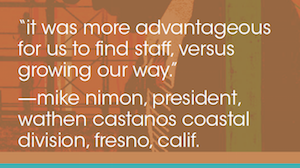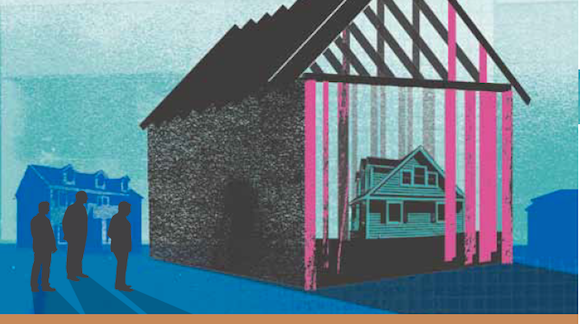 Andrew Mangano grew and sold two companies since starting as a builder in 1978, and he was at the point with his third company where he needed to grow again to cover and push past his overhead. He’d built more than 5,500 homes in California’s Central Coast, but at age 59 he was at a moment in his career where he didn’t want to be forced into taking on projects just to meet overhead expenses. He also wanted to take care of his employees.
Andrew Mangano grew and sold two companies since starting as a builder in 1978, and he was at the point with his third company where he needed to grow again to cover and push past his overhead. He’d built more than 5,500 homes in California’s Central Coast, but at age 59 he was at a moment in his career where he didn’t want to be forced into taking on projects just to meet overhead expenses. He also wanted to take care of his employees.
“It was a situation where I needed to decide whether to grow my company here and there in order to make it more profitable and cover expenses, or focus more on the land development side and sell the home building operation,” says the founder of Visalia, Calif.-based Mangano Homes.
Meanwhile, cousins Rich Wathen and Kevin Castanos had a foothold in the Central Valley and were looking for land so that they could expand to the coast. The two principals of Wathen Castanos Hybrid Homes, in Fresno, had built houses around San Luis Obispo but lacked a long-term presence in that market.
“We were looking for property in the area, and we didn’t go into our business plan with the idea of ever buying a company. That had never been on our slate of things to do,” says Mike Nimon, president of Wathen Castanos Coastal Division.
Both parties had known each other for decades as friendly competitors in the Central Valley, but neither builder was aware of the other’s situation even as Mangano was being courted by public and regional builders. The more that Wathen Castanos’ owners searched for land on the coast, the more lots they noticed in Mangano’s portfolio. Then, in June 2013, Mangano bumped into the Wathen Castanos crew during PCBC in San Diego.
“We sat down and told him what we were trying to accomplish,” Nimon says. “Andy told us what he wanted to accomplish, and we agreed that this is something we should talk about. From there we just kept the conversation going, and it worked out to a purchase.”
They closed the deal in March 2014, with Wathen Castanos taking on all 12 of Mangano Homes’ employees, assuming its liabilities, and continuing development of Serra Meadows, a San Luis Obispo development that will include 179 homes and 12 to 14 commercial lots. Through his limited partnership company, MFI Limited, Mangano focuses on finding and developing land for Wathen Castanos.
“We would have developed land and staff over time if we could have come in with our management team to the [Central Coast], but we like this template better because the staff that came with Andrew was strong,” Nimon says. “They had all the local ties, all the political guys they could consult, and the trades, so it was more advantageous for us to find a staff versus growing our way out there.”
The Wathen Castanos/Mangano purchase may be a rare example of a deal by two midsize, private builders in an arena where bigger players are expected to drive much of the industry’s consolidation. Mangano notes that he was not desperate to sell, as his company had access to capital and didn’t have a lot of debt. “I had to decide,” he says, “Do I really want to build vertical and have all the nuisances of the overhead, extended warranty issues, and logistics, or do I want to refocus my efforts and have a small organization and concentrate on land entitlements and land development?” The sale allowed Mangano to do the latter. “Personally,” he says, “I’m pretty happy about it.”
Home building has long been a fragmented industry where the ranks of small entrepreneurs outnumber their bigger competitors. Yet big builders now are grabbing more market share of home sales not only by using their access to capital to buy land, but also by acquiring other builders.
Confluence of Buyers
During a Meyers Research conference last January in Las Vegas, an audience member asked a panel of senior executives if they see consolidation afoot among the top builders. The panelists—Jonathan Jaffee of Miami-based Lennar, Sheryl Palmer of Taylor Morrison, Scottsdale, Ariz., and Adrian Foley of Brookfield’s California division—looked at one another, shrugged, and by consensus agreed that M&As are unlikely among the ranks of the top 10 or even the top 20.
Palmer said that consolidation is a matter of resetting expectations on the private builder side because most deals that occur usually are those where someone’s land pipeline or their management team attracts big builders. “How long will it take regional builders to realize that this is the best time to exit?” she asked.
 Now could be the opportune time to sell, as several factors have swelled the ranks of potential buyers compared with previous home building cycles. Some builders that cut staff, reduced operations, and avoided leveraged land positions were fortunate to be sitting on a lot of cash after weathering the recession. Once these potential suitors saw that the 2013 recovery was real, at least in the upscale, move-up market, they looked for land and new markets to move into by acquiring builders.
Now could be the opportune time to sell, as several factors have swelled the ranks of potential buyers compared with previous home building cycles. Some builders that cut staff, reduced operations, and avoided leveraged land positions were fortunate to be sitting on a lot of cash after weathering the recession. Once these potential suitors saw that the 2013 recovery was real, at least in the upscale, move-up market, they looked for land and new markets to move into by acquiring builders.
IPOs also created more buyers. After going public in 2013, San Jose–based UCP springboarded from California into the Southeast by buying Citizens Homes, in Charlotte, N.C. TRI Pointe Homes acquired five builders across the country from Weyerhaeuser. LGI Homes, of Houston, bought Oakmont Builders, in Charlotte, N.C. Newport, Calif., builder William Lyon purchased Polygon in the Northwest. Century Communities, in Greenwood Village, Colo., used the proceeds from its 144A equity placement in 2013 to buy Dunhill, in Las Vegas, and Jimmy Jacobs Homes, in Texas. Then, after going public last year, it acquired Atlanta’s Peachtree Communities in November.
“We’ve ended up with more public builders than we’ve had before, and the newly minted ones are very much in an aggressive growth mode because they have to demonstrate that they are in fact national or at least multiregional and that they can manage growth across geography,” says Jody Kahn, senior vice president with John Burns Real Estate Consulting and previously a merger and acquisitions specialist for 20 years with her father’s company, Michael P. Kahn & Associates. She adds that some of the fledgling public builders, such as TRI Pointe and LGI, could have been acquisition targets themselves if the IPO window was not open.
The top 10 publicly traded builders captured 26.4 percent of new single-family home closings (not-for-sale custom-built homes are not included) last year compared with 25.3 percent in 2013, according to the National Association of Home Builders. While the top 10 publics’ share is about even with their 26.9 percent share in 2010, M&A activity among home builders last year was the most lively since 2005, with 15 completed deals, mostly by the public companies. This year looks to be as busy since the same factors that drove 2014 activity will continue, says Tony Avila, CEO of Builder Advisor Group, in San Francisco.
Avila’s company was involved in four deals last year, such as LGI Homes’ acquisition of Oakmont Home Builders in October and UCP’s purchase of Citizens Homes in March 2014. He expects that his company will have a hand in closing between four to six deals this year.
“Your public builders are generally looking for accretion,” Avila says. “They want to increase their earnings per share, expand their presence either geographically or by product type, or both, and they’re looking to increase their ability to spread their overhead over more closings and more revenue. The private buyers that are coming into the market today are maybe less driven by earnings per share. They may be a private builder, or maybe they are a foreign investor that has a more long-term perspective, but their drivers are profitability, too.”
Kahn of John Burns sees the potential for more “partial interest acquisitions” where foreign or home-grown investors buy a stake in builders, such as Tokyo’s Sumitomo Forestry Group did with Bloomfield Homes, in Southlake, Texas, and Gehan Homes, in Dallas. Sumitomo’s Australian arm, Henley Properties Group, bought a regional Washington builder a couple of years before the Texas deals and has since expanded into Seattle and Dallas under the MainVue Homes banner.
Convergence of Sellers
Kahn added that potential sale candidates could include three regional builders that are controlled or owned by investors—John Wieland Homes, Smyrna, Ga.; Orleans Homebuilders, Bensalem, Pa.; and Woodside Homes, North Salt Lake, Utah.
“It will be interesting to watch those three and see what happens because generally the investors who step in during distressed situations don’t do so for the long term,” Kahn says. “Often it’s an opportunity to heal, fix, and solve problems, and maybe at some point these companies are going to be put up for sale or pursue an IPO as an exit strategy for their investors.”
There are as many as 20 home building companies owned by hedge funds and private equity firms, and that’s one reason why Robert Crowley, the managing director of Moelis & Co., in Boston, expects a significant jump in M&A deals during the next 12 to 24 months. Investors acquired these builders during the downturn, and eventually they’re going to want their money back.
“There are public companies on that list as well as private companies,” Crowley says. “Just because you go public doesn’t necessarily create immediate liquidity for those investors because in most of the IPOs there was little if any selling by the shareholders of the private equity firms and hedge funds. If the stock has a nice run, they may have the ability to sell down the shares in the secondary market, but that can take years, and it’s entirely subject to market conditions. If they don’t have an easy opportunity that way, they may also choose to exit through M&A as a private company.”
The Southeast could be the ripest region for M&A activity. A recent John Burns Consulting report notes that public builders own a minority of subdivisions in markets such as Raleigh (33 percent), Atlanta (36 percent), and Charlotte (42 percent). The Burns report states that 16.1 percent of the nation’s population lives in the Southeast and 18.4 percent of the population growth there has taken place since 2000, particularly with affluent homebuyers relocating from elsewhere. The momentum there is recent, since the Southeast began recovering from the housing correction later compared with other regions where home building had already picked up.
Michael Kahn, as of this writing, is representing sellers in Memphis, Tenn.; Richmond, Va.; Charleston, S.C.; and Port St. Lucie, Fla., and a public builder looking to buy in the Southeast. The principal of Michael P. Kahn & Associates, in Palm Coast, Fla., sees the deep pocketbooks of big builders and their access to capital and land as just one compelling factor motivating some builders to sell rather than compete against their bigger brethren. “Some builders are in their late 50s or early 60s; they’ve been through a downturn; they know what it’s like to get hit pretty hard; and they understand that home building is a cyclical business,” Kahn says. “Do they want to go through a couple more cycles like that again? In some cases the answer is no.”
Yet he also is representing a company run by young builders in their 30s and 40s who are doing extremely well. They are second-generation builders and are being counseled by a father who got burned in land development years before. “He’s telling them that it would not be so terrible to take some money off the table, invest it, stay dormant for three or four years with your non-compete agreement, and then get back into the business. They’re young enough to do it,” Kahn says.
On the buyer side, the reasons to purchase a builder can fall into three categories, Kahn adds. The most popular type of buyers are the builders looking to expand into new geographic markets as Meritage Homes did in 2013 when the company entered Nashville, Tenn., by purchasing Phillips Builders, keeping the brand name and the management team to run that division.
Ryland Homes is an example of a second category where the builder exited markets during the downturn and wanted to return. Rather than enter through a greenfield startup, Ryland bought builders in Phoenix, Dallas, Charlotte, N.C., and Tampa, Fla. “The point is, some companies return to markets by acquiring the management team because they didn’t have a bench or anyone to send into a greenfield startup,” Kahn says. This scenario could be a more frequent driver of M&As during the current home building cycle as there are many companies that haven’t yet returned to the locales they left during the recession.
Talent Search
A third category of buyers consists of builders that are already in the geographic markets they want to be in, but have one or two divisions that aren’t delivering as many homes as the builder would like. So the suitor acquires a local competitor to replace an unproductive team with stronger managers who can grow that location.
A key ingredient in recent deals involves buyers searching for talented management to come aboard. Agreements carrying a guarantee that the seller’s management will stay on for a specified time are not unusual. For example, Brookfield bought Grand Haven Homes not only to expand into the surging Austin, Texas, market but also to bring in three principals—Eric Rome, Mike Beckett, and Shay Brinkley—with extensive marketing experience and knowledge about personalizing upscale production-built homes that could be applied to other parts of the Canadian builder’s organization.
“I hear more grumbling from builders around the country about how difficult it is to find qualified staff,” Jody Kahn says. “Even though employment is rising and the indicators are good, I think they still feel the challenge at this time to staff businesses with proven operators who can manage both sides of the cycle.”
The trick, particularly if a buyer acquired a company from the owner and founder and put a lot of money in his pocket, is keeping that key person motivated to stick around and work hard. “It’s not impossible, but it can be a complicating factor,” Crowley says.
According to the latest tally by John Burns, public builders grabbed 34 percent of total U.S. new-home sales. While that figure is significant, it leaves 66 percent in the hands of private builders that, Kahn contends, will continue to find profitability and success by focusing on niche opportunities while not competing head to head with the publics. The flurry of M&A activity might make the drumbeat of consolidation pound even louder and squeeze smaller builders even more, but Andrew Mangano has heard that before during his 30 years in the industry.
“There is some truth to that, but I don’t see [consolidation] as being pervasive because the smaller guys are often in smaller markets that the bigger companies don’t want to come into,” Mangano says. “They have institutional knowledge of the market they work in, and that gives them a leg up. Their biggest issue is attaining enough capital to do what it takes to make projects successful in today’s environment.”
Advertisement
Related Stories
Housing Giants
The 2024 Housing Giants Survey Is Now Open!
Complete the 2024 Housing Giants Survey to see if your company makes the cut in Pro Builder's rankings of the largest home building companies in the country
Housing Giants
Builder Rankings by Revenue: 2023 Housing Giants List
Pro Builder's annual Housing Giants rankings list provides a snapshot in time of builders’ perceived opportunities and challenges. These are the top 240 home builders in the nation, ranked by revenue
Housing Giants
Holding Back the Headwinds
Stormy market conditions strained the nation’s largest home builders in 2022, and they’re bracing for more uncertainty









